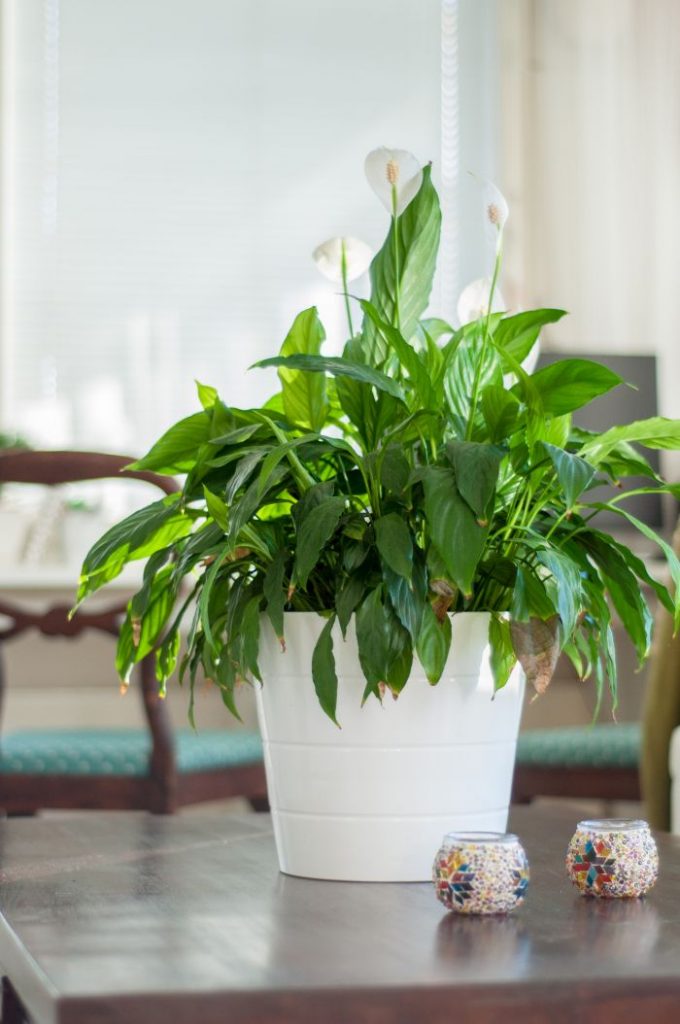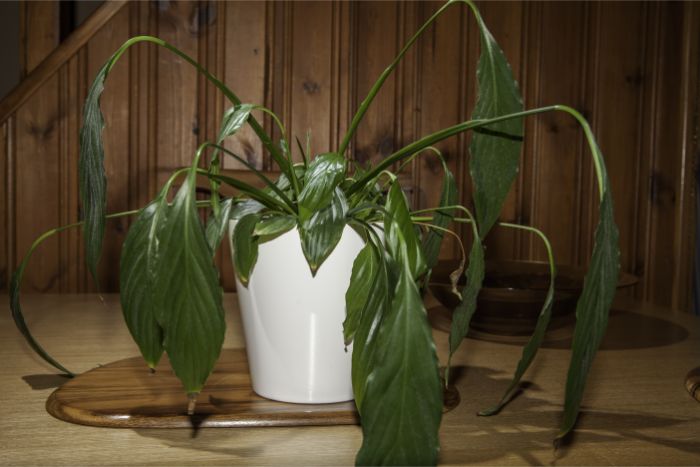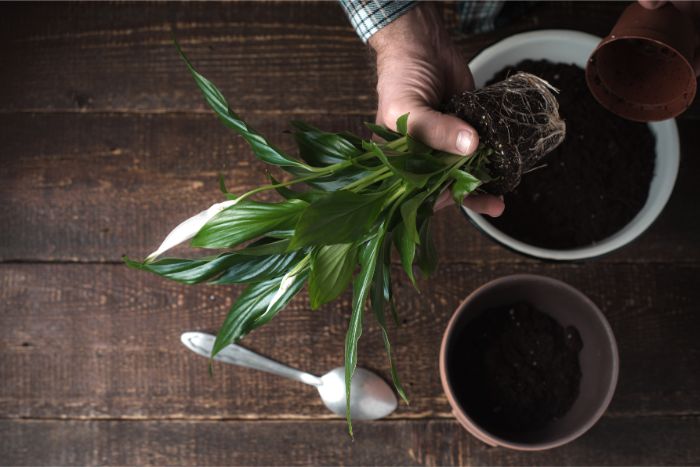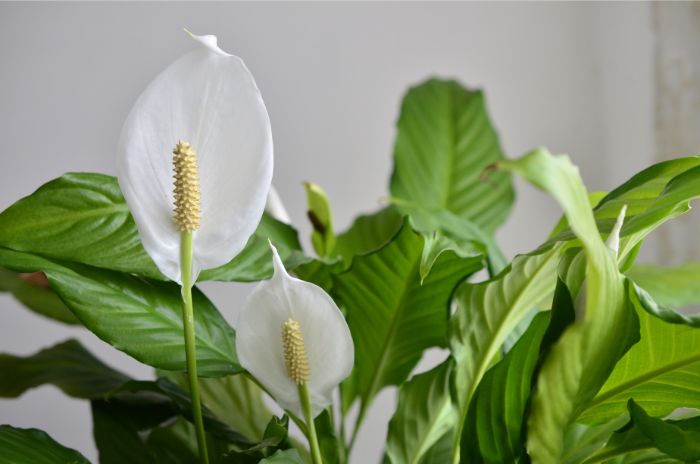The Peace Lily (Spathiphyllum) is a really popular indoor plant that is both beautiful and easy to care for. Although they are a great choice no matter what color of thumb you have, sooner or later you may find your Peace Lily drooping . Don’t panic, as this is a common problem which can be managed easily. This article will explain why it happens and how to prevent and treat your Peace Lily so it thrives once more.
Why is my Peace Lily drooping? The main reason why Peace Lilies droop is because of overwatering and underwatering. Other possible reasons include:
- Too much direct sunlight.
- Insect infestation such as Mealybugs.
- Temperature that is too high or too low.
- The wrong type of soil or poor soil conditions.
- Low humidity levels.
- Disease.
With the right know-how and a few basic plant care techniques, you can find out what the problem is and fix it. Read on to learn more about the reasons a Peace Lily droops and what you can do to turn the situation around.
7 Reasons Why Your Peace Lily Is Drooping
How quickly your plant recovers will depend on how promptly you react to the problem and if you are willing to put in a little bit of effort to assist in the recovery process. Below is an elaboration on the 7 most common reasons why Peace Lilies droop and what you can do about it.

1. Overwatering Or Underwatering A Peace Lily Can Lead To Drooping
The Peace Lily is an Aroid and as such, they have thick glossy leaves and a lush looking spathe. Naturally, these plants grow and thrive in tropical rainforests, so it stands to reason that they like their water. This does not mean that they like to be continually drenched though.
How Underwatering A Peace Lily Causes Drooping:
Underwatering your Peace Lily leads to drooping as the stem and leaves are not being provided with sufficient water and nutrients from the root system. As a result, the plant starts to dehydrate and droop.
Peace Lilies have a tendancy to droop quite suddenly once they do not have enough water. It’s not uncommon to have a healthy looking plant one day, only to find your plant drooping significantly the next.
The trick with Peace Lilies is to be alert enough to water them just before they start to wilt and droop. Luckily, the plant is fairly resilient and if the leaves are drooping from underwatering, you can give it some water and expect to see it pep up very quickly.
Leaving a Peace Lily thirsty for too long can lead to yellow, dry leaves, so try not to leave your plant without water for too long after it starts drooping. Learning about the factors that influence the frequency you need to water your houseplants is a great skill to learn to help keep your indoor plants happy. I have written a complete article about this here.
How Overwatering A Peace Lily Causes Drooping:
Unfortunately, an overwatered Peace Lily is less forgiving than an underwatered one – especially if you leave it for too long before taking action.
When you consistently overwater a Peace Lily, it causes waterlogged soil, leading to root rot. Once root rot sets in, the roots cease working and die off.
The plant is then unable to absorb water and nutrients, so although there is plenty of water in the soil, it can’t reach the leaves of the plant, leading to drooping.
Generalized yellow leaves on your peace lily is often a sign of overwatering, so take action immediately if you see this. I’ve covered the reasons why peace lilies get yellow leaves in this article, which you may like to read.
To avoid overwatering, make sure that your house plant has soil that drains well and that you do a soil check before you water the house plant – every time!
2. Too Much Direct Sunlight Can Cause Your Peace Lily to Droop
Peace Lilies prefer partially shaded spots to grow in. You might even be surprised to find that a Peace Lily also does well in a low-light environment. This is no surprise as in nature Peace Lilies grow under the forest canopy, and rarely receive direct sunlight.
Whilst a Peace Lily will tolerate a few hours of direct sunlight per day, particularly in cooler climates, it cannot tolerate prolonged direct sunlight. This will result in burnt leaves that will become dry and develop brown patches or tips.
Drooping happens because the increased light and heat exposure means a higher transpiration rate, which ultimately means more water loss. When this happens, the plant naturally droops.
What To Do If Your Peace Lily Is Drooping From Too Much Direct Sunlight:
- Move your house plant away from the window.
- Choose spot that is bright, but doesn’t actually get direct sunlight.
- If you have the house plant on a patio or similar, move it into a shady corner.
3. Insect Infestations Can Cause Your Peace Lily To Droop And Wilt
Not all bugs and insects like to feed and live on Peace Lilies, but Mealybugs do. And the damage that Mealybugs can cause is quite extensive if left unattended.
These particular bugs attach themselves to the stem and leaves of a plant and proceed to quite literally suck the life out of them by consuming the plant sap. Naturally, the plant will start to dehydrate and droop when this happens.
If your Peace Lily is drooping, take a closer look to see if you can see any insects or bugs at play. If you see little fluffy tufts of white on your house plant’s stems and leaves, you most likely have a case of Mealybugs.
Mealybugs live in colonies, so you will never just have one at a time to deal with. You will have a mass of them to handle.
How To Get Rid Of Mealybugs:
- Clean the plant with alcohol to remove bugs or insects.
A great method to get rid of Mealybugs is to spray them with 70% isopropyl alcohol. This is entirely safe for your Peace Lily, but deadly to Mealybugs. This can be purchased in a handy spray bottle and is great for getting rid of all kinds of houseplant bugs. Just generously spray the foliage from the top and bottom, to make sure the entire plant gets treated.
One day after doing this treatment, I put my Peace Lily in the bath and give it a gentle rinse with cool water to remove any of the dead bugs. If any bugs remain, you can use a cotton swab or cloth soaked in rubbing alcohol to remove each bug by hand.
A good alternative to using rubbing alcohol is to treat your Peace Lily with a dilute solution of dish soap. Add 1 teaspoon of dish soap to 1 liter of water. Mix well and pour into a spray bottle. Spray the plant generously, ensuring that you cover the plant completely.
The next day, rinse the plant with water as previously suggested. Although using dish soap on plants is generally safe, you need to ensure that it is well diluted. Whilst Peace Lilies will be fine using this treatment, some plants wont tolerate dish soap at all. I found out the hard way.
If you want to learn more about getting rid of houseplant bugs, I have written a great article here about natural ways to get rid of indoor plant pests.

4. High And Low Temperatures Can Lead To Your Peace Lily Drooping
It might be hard to believe that Peace Lilies prefer average indoor temperatures. Especially when you consider that they originate from tropical areas. Most Peace Lilies will happily flourish in temperatures of between 65-75 °F.
At night, the plant will be okay if the temperature drops by around 10 °F. If the temperature drops much lower or rises much higher than that, your Peace Lily will start to show signs of drooping.
How To Ensure Your Peace Lily Is Not Exposed To Temperature Fluctuations:
- Keep your house plants away from doors that are frequently opened and closed (and windows too). The drafts that come in as people enter and leave the room can cause serious temperature fluctuations for your plant.
- Do not place your house plant next to or near the heater or fireplace. The heat that emanates and then dies down only to be fired up again can create temperature fluctuations that the plant just cannot get used to.
- Keep the houseplant a decent distance from the air conditioner and out of its direct line of air gusts. Do similar for the fans in your home, if you have any. Drafts of air can cause the temperature to fluctuate.
If your plant is drooping and you suspect it is temperature fluctuations that are to blame, take the time to move the plant to a more suitable spot and monitor its progress for a few days.
If you see no improvement in a few days, changing temperatures might not be the reason why your Peace Lily is dropping and you will have to carry out further investigations.
5. The Wrong Type Of Soil Or Wrong Soil Condition Can Cause Peace Lilies To Droop
Peace Lilies are not particularly fussy plants, but if their soil does not drain well and becomes waterlogged, they tend to show their discontent fairly quickly. It is essential not to waterlog your Peace Lily’s roots.
This can lead to root rot and the overall demise of your plant. It is important to provide your house plant with a good growing medium. Failing to do so can just lead to complications for you and the plant. Drooping leaves in the Peace Lily can indicate one of 2 things when it comes to soil type or soil condition:
- The soil is becoming waterlogged and is not draining sufficiently. The ultimate result of this is drooping leaves due to root rot. When the roots rot, the plant can’t get the water and nutrients it needs and so, the leaves and sometimes even the stems start to droop down.
- The soil is draining too quickly and the plant is unable to sufficiently absorb nutrients and water.
Peace Lilies Do Not Like The Following Soil Types:
- Clay soils – soils with a high level of clay often lead to waterlogging or very slow draining of water, which is not ideal for the Peace Lily.
- Gritty or sandy soils – as mentioned above, gritty soil drains the soil too quickly which does not leave enough time for nutrients and moisture to be absorbed.
If your Peace Lily is drooping and you have come to suspect that the soil type or condition is to blame, you can turn the situation around quite easily by repotting the plant in fresh, more suitable soil. Choose a fine yet porous potting medium for your house plant. It should contain a mix of perlite, peat moss, and fine bark, if you want the best growth out of this particular plant.

6. Low Humidity Levels Can Lead To Peace Lilies Drooping And Wilting
Peace Lilies like warm climates with high humidity levels. If the air is dry with very low humidity levels, your house plant may start to droop. Other signs that a house plant needs more humidity include:
- Edges of the leaves start to turn brown.
- Yellowing leaves.
- Foliage starts turning hard and crispy.
If the environment that the plant is growing in has low humidity levels and your plant is drooping, you can rectify the situation by increasing the humidity levels. A few ways to do that include:
- Mist your Peace Lily frequently.
Misting increases humidity effectively, but the humidity will be temporary. You will have to keep misting the plant regularly to keep the humidity levels high.
- Invest in a portable humidifier.
An electric humidifier is an easy way to increase humidity effectively. Many will enable you to maintain a set humidity level.
- Place your house plant on top of a tray of wet pebbles.
Use a wide tray with pebbles scattered around the base. Add water to the tray without fully covering the pebbles. The bottom of the house plant’s pot should not be resting in water or get wet. This will naturally increase the humidity levels around the plant.
- Double pot your Peace Lily.
Place your potted Peace Lily inside a larger container. Then fill the space that is between the two pots with Sphagnum moss. This will increase the humidity around the plant and offers these benefits on a fairly long-term basis.
- Position plants strategically.
If some rooms within the home are more humid than others, choose those rooms as the living spots for your Peace Lilies. They will thank you for it by flourishing.
Read my article which discusses how to increase humidity for houseplants in more detail.
7. Diseases Can Cause Your Peace Lily To Droop And Wilt
The Peace Lily is prone to a type a disease that is called Cylindrocladium root rot. This disease usually presents itself during the summer. This type of root rot is a disease that causes the plant to droop and can cause color changes on the leaves and steams too. If you suspect that your plant has this disease, here is what you can do:
- Check the roots of the plant.
If the roots aren’t wet and looking affected, then you are not dealing with a case of root rot. If root rot is present, the area will probably be wet and there will be brown discolorations and mushy parts on the roots.
- Use a fungicide.
Remove the plant from the pot and gently remove all of the old soil from around the roots. Use a sterile pair of pruning shears to remove the worst affected roots. Spray or dip the roots in a suitable fungicide to kill any of the fungi that remain.
- Refresh the living environment and growing medium.
You should replant the Peace Lily in a new pot and with fresh soil that drains well. Discard the old soil and wash the gardening tools used in order to get rid of potential contaminants. Fungal diseases can spread through soil and if you fail to wash your equipment or change the soil, your plant could continue to suffer the same plight and you could even infect other plants.
As this particular disease is caused by overwatering, it is important to watch your watering habits going forward. Assess the plant carefully using these tips to decide when your plant needs water.
Last Word
As you can see, Peace Lilies can droop for a variety of reasons. Before you choose your course of action or treatment, it’s best to investigate each cause carefully to make sure you treat your plant correctly.
The easy-growing low maintenance Peace Lily can be quickly and effectively restored to health if you are willing to do a bit of investigative work and then get to work on reversing or rectifying the situation.

